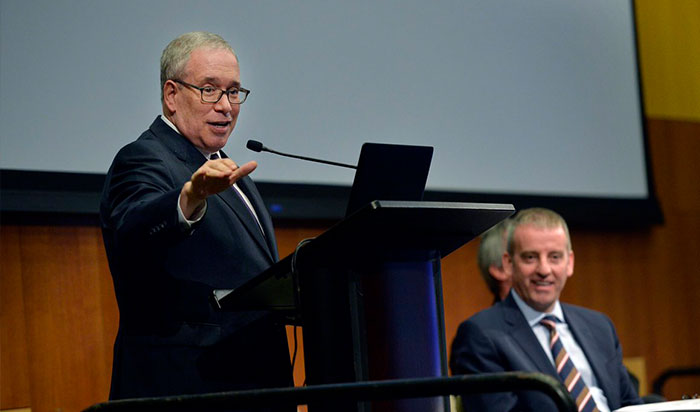Photo Courtesy of Comptroller Stringer’s Office
Comptroller Stringer had plenty to smile about this week as he delivered more positive economic news.
By Forum Staff
Gotham’s economy experienced moderate growth as unemployment continued to fall to record-low levels in the third quarter of 2018, according to an economic update released on Thursday by City Comptroller Scott Stringer.
The city’s economy expanded 2.8 percent in the third quarter of 2018, roughly the same pace as in the first and second quarters; while the Big Apple unemployment rate, adjusted for seasonal variations, fell to 4.1 percent in Q3 2018from 4.2 percent in Q2 2018, the lowest rate on record, Stringer said. And more New Yorkers are working than ever before. The number of employed city residents increased by 6,200 in Q3 2018 to a record high of 4,055,300.
Additionally, the comptroller noted that the U.S. unemployment rate fell to 3.8 percent in Q3 2018, the lowest rate since 3.6 percent in the fourth quarter of 1969.
Private sector jobs growth accelerated, according to the analysis, but largely in low-wage industries. Private sector hiring grew at an annual rate of 1.5 percent in Q3 2018; however, of the 15,100 private-sector jobs added in the third quarter, 11,700 (77.4 percent) were in low-wage industries. The largest private-sector job gains were 10,100 new opportunities in health care and social assistance; 3,600 jobs in leisure and hospitality; and 3,000 new jobs in professional and business services.
Stringer’s report also indicated that commercial and economic indicators remain strong. Venture capital investment in the New York metro area surged by 31 percent to $5.86 billion in Q3 2018 compared to a year ago. However, the number of deals in the New York metro area fell to 159 in Q3 2018 from 213 in Q3 2017, following a similar trend nationwide.
New commercial leasing stayed strong, rising 18 percent from the year before to about 9.6 million square feet in Q3 2018. Commercial rents remained stable and vacancy rates fell slightly citywide. The comptroller noted that the residential housing market weakened in part due to federal changes to state and local tax deductibility, rising mortgage interest rates, a lower limit on mortgage-interest deductibility, and a stronger dollar overall.
Unlike in Manhattan, housing prices increased in Brooklyn and Queens. The average sales price in Brooklyn rose 7.2 percent to $1,051,999, while the average sales price in Queens rose 3.4 percent to $635,281. However, the number of sales decreased, increasing listing inventories, Stringer reasoned.
And weekday ridership on MTA NYC Transit fell 3.1 percent in Q3 2018 from a year ago as subway ridership fell 2.6 percent and bus ridership fell 4.7 percent. Ridership on the Long Island Rail Road rose 0.8 percent, but remained unchanged on Metro North.
“The numbers here show that New York City’s economy continues to be strong yet we still have improvements to make. While more New Yorkers are working than ever before, new jobs are concentrated in low-wage industries, preventing them from achieving economic security,” the comptroller added. “We have to ensure that economic growth lifts New Yorkers up—and to do that we must increase access to jobs with better wages as well as affordable childcare, housing, and educational and job training opportunities.”
Released every three months, the Comptroller’s Quarterly Economic Update tracks NYC’s economic health and analyzes its economy in a national context.

